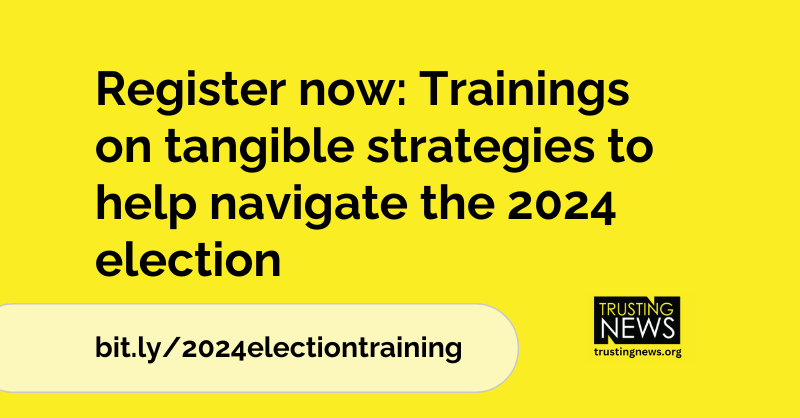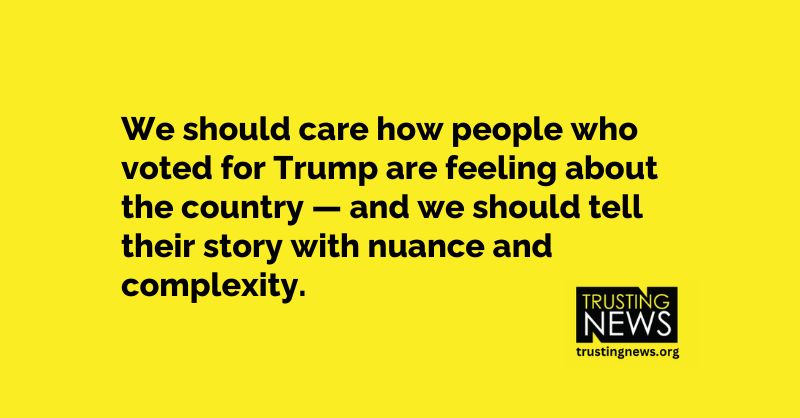
In this webinar series, you’ll learn Trusting News best practices and tips so they can feel confident going into Election Day
Webinar series: Strategies for useful, trusted election coverage
Many people are overwhelmed by election news and would love to tune it out altogether.
We know journalists are feeling overwhelmed too, and are often strapped for resources as they work to cover what feels like a constant influx of breaking news.
But if we as journalists want our coverage to aid in civil discourse and civic engagement, we need journalists to commit to producing coverage that’s seen as fair and even-handed by news seekers across the political spectrum — and for people who are not engaged at all.
In this free training series, Trusting News is focusing on quick, actionable steps journalists can actually DO ahead of the 2024 election to help coverage feel credible and accessible to a larger audience.
Here’s what you can expect: Each session, we’ll spend 45 minutes focusing on how journalists can take action. We’ll include perspectives from partner journalists and show examples of how they’ve implemented these strategies in their own newsrooms. Then we invite you to stick around for another 15 minutes if you have questions or want help brainstorming.
Register here and you’ll get access to all of the webinars, but feel free to pick and choose the sessions that feel most helpful for your work.
Looking for customized election support and advice? Fill out this quick form to get one-off coaching from Trusting News on any specific part of your election coverage.
Trusting News election trainings
1. Reach beyond political junkies: Election coverage for news avoiders
1–2 p.m. EST, Thursday, Aug. 15. News coverage (especially election coverage) often feels like it’s made for political insiders and those who are already paying close attention. That makes it hard for other people to plug in, and it can leave them feeling less engaged in the topic and less likely to tune in again. That’s bad for news outlets, and it’s also bad for civic engagement. We’ll share ideas and strategies for how journalists can make the news feel more accessible and inviting to people who aren’t political junkies. This session has passed. Watch the replay here.
2. Depolarize the news: Avoiding common pitfalls that make coverage feel biased
1–2 p.m. EST, Thursday, Aug. 29. Too often, coverage amplifies extreme views and ignores more nuanced ones, reinforcing the idea that people are split into political camps and an “us versus them” mindset. This causes news consumers to lose trust in the news — and to assume journalists have picked sides themselves. In this training, we’ll talk about how journalists can avoid common pitfalls that often can send signals of bias and alienate people from news coverage. This session has passed. Watch the replay here.
3. Bring your receipts: Explaining your reporting process
1–2 p.m. EST, Thursday, Sept. 12. Not everyone we’re trying to reach with our news coverage is coming from a shared set of facts. When journalists publish something they accept to be true — such as the results of an election — what happens when that statement feels like unsettled opinion to some of your audience? How can you as a journalist back up the facts you’re sharing? How can you show that your work is fair, accurate and trustworthy? In this training, we’ll walk through how to bring your reporting receipts by both explaining how and why you stand for facts, and by showing how you consistently source information and stories. This session has passed. Watch the replay here.
4. Avoiding polarization when reporting on hot-button issues
1–2 p.m. EST, Thursday, Oct. 3. Whether it be the headline, who you interviewed for the story or the language used, when covering a controversial topic, it’s almost guaranteed someone will disagree with your coverage — or at the very least, make quick judgments about it purely based on the topic. In this training, you’ll learn strategies for how to cover hot-button issues without alienating or overgeneralizing segments of your community. We’ll talk about how to signal fairness and explain your work in a way that makes the coverage more accessible by people with different views on the issue. We’ll be joined by John Diedrich at the Milwaukee Journal Sentinel, who will share his fresh approach to his award-winning series on guns and how he was able to find common ground across the political spectrum. This session has passed. Watch the replay here.
5. Lightning round: Tips for Election Day
1–2 p.m. EST, Thursday, Oct. 17. A lot of people pay extra attention to the news on Election Day. Are you ready to capitalize on it by being relentlessly useful and showcasing your credibility? In this webinar, Trusting News will share tips for quick-lifts you and your newsroom can still plan to do to increase trust in your coverage. You’ll leave with efficient, accessible ideas you can implement right away, with a checklist to use on Election Day. This session has passed. Watch the replay here.
Questions?
Please reach out if you have questions or need clarification! You can reach our team at info@trustingnews.org.
New resource: Election Trust Kit
Trusting News also launched a new resource, Election Trust Kit, that walks journalists through strategies and ideas for how to craft election coverage that resonates as fair, even-handed and reliable — across the political spectrum.
Check out the Trust Kit here.
At Trusting News, we learn how people decide what news to trust and turn that knowledge into actionable strategies for journalists. We train and empower journalists to take responsibility for demonstrating credibility and actively earning trust through transparency and engagement. Learn more about our work, vision and team. Subscribe to our Trust Tips newsletter. Follow us on Twitter and LinkedIn.




